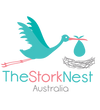The top breastfeeding positions to know about!

Recline Cradle hold
This is my go-to breastfeeding position and the position I find to be the most sustainable for the majority of breastfeeding mothers. This position is very intuitive for mum and baby. Baby's weight is spread over mum's torso, rather than being concentrated in her forearms which tire quickly during long feeding sessions. Mum can choose to recline as far back as she likes, and this position works great in bed and on the couch. Partners often comment on how comfortable mum looks in this position compared to other feeding positions.
- Reclining the torso helps to elevate the breast and nipple, placing the nipple in a more accessible position if the nipple is low
- Reclining back helps to stabilise the baby, supporting them to drink in a more coordinated way (great for mums with a generous fast flow)
- The non-feeding side arm is free for snacking, hydration, and sensory nourishment for baby
- Gravity helps the baby to stay deeply attached to the breast, this places baby slightly on top of the breast, rather than drinking from below
- Shoulders can be relaxed, and head titled back rather than looking down over baby
- Reclining takes the weight off the pelvic floor

Rugby hold… smaller babies and larger breasts or low nipples
This position is commonly introduced in the early days and can be a great option for some mums and their babies. I find this position doesn't work well if your baby is average or above-average birth weight as they quickly run out of room, and are generally heavier to support with the wrist. Be very mindful that shoulders do not slump forward, I find this posture can be very straining on the back, neck and shoulders. If you have been predominantly feeding in this position, try the other two in the previous slides to give your posture a break from this particular style. More pillows are required with this position, and this leads to difficulty feeding outside of the house.
- Ideal for mums with fuller breasts who aren't easily able to visualise their baby's face easily
- Ideal for mums with a lower nipple position, the baby can attach from underneath the nipple rather than above
- Can be ideal for a smaller baby, and also for twins when they are ready to tandem feed
- Pillows must be used strategically to support the baby deep into the breast, taking the weight off mum's wrist
- Make sure the baby's body is far back enough under mum's underarm, so that baby's head can be tilted back to allow for easier swallowing

Cross cradle… most common position taught in hospital, good to know the basics
This is the position you will be taught most frequently during your hospital stay. It is very instruction-heavy, and the multiple steps can feel overwhelming for new parents. Sometimes this position will work for baby’s who are struggling to latch, who may be smaller and need some active shaping of the breast to help support a deep latch. Knowing about holding your baby in the right way will help reduce nipple pain, their cheeks should be pressed in equally (the top and bottom touch the breast to the same degree), their nose should be flush and their chin should be buried.

Side lying …early postpartum, supports rest and pelvic floor recovery, very calming for baby
This is another favourite position and works extremely well to support postpartum recovery. I also love trying this position when the baby is particularly fussy at the breast, as they are much calmer when lying down. This position gives mum's arms and pelvic floor a break from feeding in more upright positions and is a beautiful way to promote rest during the first 40 days.
- Great to try if the baby is fussing before or midway through a feed
- Try this position when mum and or baby need some physical rest
- The side-lying position helps to support the weight of a fuller breast, leaving the mum feeling more supported
- Great for mums who are in need of some pelvic floor support after birth
- Very relaxing position for mum and baby
- Gives mum's back, arms, neck and shoulders a break from other feeding positions
Joelleen Winduss Paye, IBCLC Lactation Consultant, Midwife & Naturopath
JWP Holistic Lactation Consultant
www.jwp.care @jwp.ibclc

